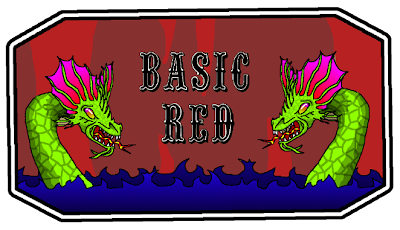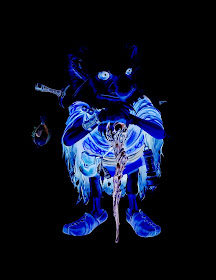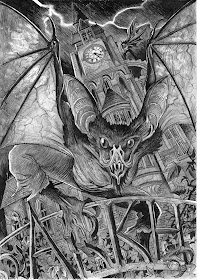I generally have a low opinion of rpg fluff for someone who puts out so much substandard rpg fluff. That's really the crux of the issue for me. In this room, my office, next to the television, in the can, under the bed, heaped in the garage, accessible from space at the touch of a button, I can reach out and find awesome RPG inspiration in terms of plot or story, or even structure, or modular obstacles. I have the entire make-em-up world and can choose from Lovecraft or LeGuin, Jack Kirby or Jack Kerouac, Li Po or Edgar Allen Poe. From Shakespeare to Star-Spangled War Stories. Even better, I have the entire real world, all of human endeavor and history, the record of centuries of fuckups and bumps in the night. BOOKS ABOUT DINOSAURS. I can put together a thousand nights and hours of dungeon, town, and castle, all without ever having an original idea. I imagine many would say I in fact do this. This is the seed of my distaste for established D&D settings. I have access to the stories that created the tableau you're set against, why would I settle for the fire shadows dancing upon it? It's also why I have little patience for lore-packed books for licensed RPGs. Hate it, fine, but Star Wars changed how films worked as a business, how they were marketed and to whom, and opened doors for people's perception of science fiction as a fiction-first vehicle for the masses. Anything that makes me want to play a Star Wars RPG is in that film's running time, not in Wookiepedia articles debating Trandoshans or information on Geonosian commerce. I don't know if I spelled all of that correctly but I hope I did not. I even hate it when games front-load their book with lore. Legend of the Five Rings looks like a fun time in the tradition of "Guys it's all basically just Asia right?" but I'll never know, because the rulebook in the store is 100 pages of history and factions and strictures and homework before a character creation section which goes "Now based on what you just read, A, B, or C?"
What I look for in a RPG book is tools. If I find tools I like to use, I will wrap any old thing around them. Your lore may be vast and beautiful and just as good as anything I could get from anyone else, but I doubt it, and were that even the case it would still be a case of asking for blueprints to build a home and being shown a verdant and chirping forest. The amount of time it takes to make even one pass on your fluff and I could be a third of the way through a real book, or spend that time reading about real history...
A real book.
+Patrick Stuart and +Scrap Princess sent me a real book recently, much to my surprise.
I was certain this would be something like a monster manual, which is sometimes a great set of tools, a house of irregular and malshaped dressmaker's dummies one can hang different forms and patterns on as needed. Not like any monster manual I'd ever read, I was certain, but still of its genus species. That was my expectation. My expectation can fuck off I guess because Fire on the Velvet Horizon is better than me.
I don't mean that it's better than I expected, although it is, even with expectations heightened by things like Deep Carbon Observatory or Knowing Who They Are At All. I don't mean that it's better than anything I could have written on these subjects because obviously it is, and obviously it would never occur to me to write about the Mobiusnail because I'm not name level great yet. I mean that I have failings as a person which the book charitably ignores, reaching out a hand to draw me into its panic-sweat-smelling darkness. In compassion. I recently described the art of reading The Invisibles as fucking the book back, and I think that applies here, too, though Fire on the Velvet Horizon is the more gentle lover. Albeit one filled with spiders.
Before I start sounding like the infamous Harry Knowles review of Blade II, how about some usable information:
So that's $0.30 per creature, cheaper than most gumball machines these days, though if you approach the book like that you have already lost to the book.What I look for in a RPG book is tools. If I find tools I like to use, I will wrap any old thing around them. Your lore may be vast and beautiful and just as good as anything I could get from anyone else, but I doubt it, and were that even the case it would still be a case of asking for blueprints to build a home and being shown a verdant and chirping forest. The amount of time it takes to make even one pass on your fluff and I could be a third of the way through a real book, or spend that time reading about real history...
A real book.
+Patrick Stuart and +Scrap Princess sent me a real book recently, much to my surprise.
I was certain this would be something like a monster manual, which is sometimes a great set of tools, a house of irregular and malshaped dressmaker's dummies one can hang different forms and patterns on as needed. Not like any monster manual I'd ever read, I was certain, but still of its genus species. That was my expectation. My expectation can fuck off I guess because Fire on the Velvet Horizon is better than me.
I don't mean that it's better than I expected, although it is, even with expectations heightened by things like Deep Carbon Observatory or Knowing Who They Are At All. I don't mean that it's better than anything I could have written on these subjects because obviously it is, and obviously it would never occur to me to write about the Mobiusnail because I'm not name level great yet. I mean that I have failings as a person which the book charitably ignores, reaching out a hand to draw me into its panic-sweat-smelling darkness. In compassion. I recently described the art of reading The Invisibles as fucking the book back, and I think that applies here, too, though Fire on the Velvet Horizon is the more gentle lover. Albeit one filled with spiders.
Before I start sounding like the infamous Harry Knowles review of Blade II, how about some usable information:
- This book is bigger than I thought it would be, dimension-wise. It's a full-sized RPG product which means it's like having a ream of night slotted into your bookshelf.
- There are 100 creatures in here although technically that number is a bit fuzzy and there may be more, thanks to discussion of types.
- It costs 30 bucks and you can only get it on Lulu.com I think.
An implicit setting emerges from this book and the sniping sages quoted therein, one where these creatures are all strange, rare, remote, yet the populous of the monstrous is so large in general that it's impossible not to form some observations regarding these creatures. These perspectives, like the blind men and the elephant, give you another shadow for the world each time without seeing what the source of the fire is.
The individual creatures are strange and bigger than us and indifferent to us, largely, unless we are useful to them, which is to say usable and disposable by them. There's a boat of Patrick's text resting on an ocean of art from Scrap Princess. I don't mean her illustrations, actually, because of course those are great. I mean the hurried punk rock art school layouts Scrap has hand-customized for each creature. There is a secret care and exactness used to make the world of these creatures intense and frenzied.
The book is not entirely devoid of tools, particularly its brief appendices, but this is not the kind of RPG book I get excited by or seek out.
I fucking love this thing though.
When I look to histories and bestiaries and Wikipedia and Swamp Thing and Snow Crash what I'm looking for is things beyond me. Well this book certainly is. Great art insists on being engaged on its own terms first, in addition to whatever you bring to things. Great art makes you want to make great art, even knowing it will take years to get there. Great art makes you want to tell people about it. Great art is, first, itself, and you can call it singular I suppose but I prefer to label it A Thing Which Needn't Be Another Thing. Beause, y'know, a thing can just be itself.
Fire on the Velvet Horizon is not here to impress you but it will. It'll impress you pregnant. This is an example of those fine hand-crafted artisinal terrors they have down at the evil farmer's market.
Here's one way you know it's good: I care not a whit for spoilers as a concept but I don't want to discuss anything in detail. Not on your behalf. I don't want to take that experience away from the book. From Pat and Scrap. They worked hard and the book demands it.
I will push past this impulse for a few specific points:
- I have been yelling MY TEEEF at my wife for days now and she wants it knows first and foremost that This Is The Worst Thing And I Hate It.
- BLATSITSU! is a delight.
- I enjoyed the twin introductions to this book more than I've enjoyed some books.
- I keep calling the Mobiusnail the Snailsnail, which is a lack of careful reading on my part but I am sticking with it. This is also one of my go-to entries for reading to people to get them interested in reading the book.
- Every. Single. Person. I hand this to comments on Swamp Drunks.
- Aeskithetes are going in prrrobably the very next thing I run.
- There kind of are dinosaurs in it.
- This book teaches you a dialect you need to read it.
- Specific layout standouts: Priest of Hooks, Thug Bugs, Blathering Bird, much-linked Flammeous Lads, Monster Maiden.
- Specific illustration standouts: Hadeans, Colour Monster, Moon Ape, Valkyraptor, Vore Bull
- Specific description standouts: Jukai City, Mobiusnail, Umbra-Technical Elemental, and for that matter the copy on the back is faboo.
It deeply shames me to know that, six years ago, four even, I wouldn't have given this book the time of day. It doesn't come with convenient stat blocks and tool chests for me to bust out on the fly and set up a lean-to adventure, and it doesn't come super conveniently. I was one of those who may now balk at the price for what amounts to a crunchless monster manual. It's just...that's not what this is, guys! And it casts the world of DIY D&D in new clay to think how much I might be missing out on like this. Because this is a work forward. This is the next thing. This is a vision which energizes me, a delicately crafted voice, and an excellent physical thing.
It's like it's a real book or something, oh fuck that's because it is, because I realize now that I don't hate established settings and RPG lore and licensed fluff or any of that, I just hate reading things that suck. That gives me a lot of hope, because things can always suck less. So can I. Maybe that will be what we all have after everyone buys Fire on the Velvet Horizon right now.
I hope so, but at the same time oh fuck are we going to have to bust our asses to get past that.
------
Review proper (or as proper as I ever do anything) over and done, I'd like to talk a little bit about why this pushes my buttons so much. There are a number of trends in this book, basically just the kinds of things Scrap likes to draw - birds, loping curling shapes that lend well to serpents and tentacles, insects, sad or bothered people, dead eyed intelligence, mouths, bugs, darkness. The creatures have their father in them as well, wearing Patrick proudly in age, rumor, confinement and traps, madness and lies, darkness of the soul, darkness of the down deep, darkness beyond age, strength, waiting, hunger, and dignity, and prose poetry. I love these people so I'm obviously likely to be in the bag for them.
However, there are different ways to approach monsters, and this book isn't chiefly concerned with them. This is another reason I don't call it a monster manual. (Bestiary sounds too placid, something like creature compendium too fancy and uh legally protected...I'm going with Thingtionary.) The monster sections of RPGs I usually play or the monster manuals in support of these worry about how frequently you run into them, how dangerous they are, and how likely they are to run away in the middle of a fight. Sometimes these things are addressed in Fire on the Velvet Horizon but it is usually incidental to concerns of why and where you might encounter these creatures, how they behave and what they can do, and whether they fit into a previously unconsidered or unexplored aspect of the natural or social system you dwell in (and, when they don't, detailing the separate but linked system which they do inhabit). It does more than paint the invisible world layered on top of us, but instead something like a quantum matroyshka effect, where a hundred worlds are all inside and around each other.
That's what I like in a monster. I like a creature who wouldn't necessarily have its life bothered or improved if man went up in a puff of smoke one day, or Vancian spells just stopped being things. A creature with a behavior and an agenda, sure, but not a directive and a pattern prescribed to my table. Not a dragon but a 'grate wyrm.' Something bigger and older than the idea of giving a fuck about anything so impermanent as human ambition and sorrow. Little furry avalanches and huge scaly-winged things which breathe AIDS. Not just animals and not just people with bits on and not just magic powers in a neat row with Morale 12.
Wildness. The wildness of life, wilder than the physics of life could normally allow to be. Not just existence but little lives of their own. Like how any cyclops that isn't Harryhausen's cyclops can just piss off.
Strange Bestiary, Iron Kingdoms Monsternomicon, Numenera monsters, four phone books of Pathfinder stats including some for Mothra and Cthulhu, and the nice shiny 5e DMG mostly don't give me this. They give me Star Trek ecologies and the notion of nature and threats as kingdoms, as clusters, and following conventional causality. Fire on the Velvet Horizon does that for me. I mean, of course there are Colour Monsters, it's such a lived in concept that it has to come from the lived in world.
This review would have been up already except I had to stop twice to go write around something Patrick and Scrap did in here, making sure I didn't hew too close to one of their ideas.
This review would have been up already except I had to stop and write something else like RIGHT NOW while reading some of this because my brain just slips into that gear.
This review would have been up already except I kept stopping to answer "What are you reading?" by reading long passages out loud.
This review would have been up already except I kept chasing people down to show it to them and I couldn't very well finish writing it in the cold lonely empty world of No Book Now where no one even pities you but they should.










